Galeotto fu il film e chi lo girò: come scoprire la Nuova Aquitania attraverso il cinema
Due film bellissimi e un romanzo giallo per lasciarsi trasportare in Nuova Aquitania. E resterete folgorati dalla bellezza di questa regione.

Due film bellissimi e un romanzo giallo per lasciarsi trasportare in Nuova Aquitania. E resterete folgorati dalla bellezza di questa regione.

(English translation below)
Oggi vi dico come sono finita in Nuova Aquitania. E’ stato il cinema.
Quante volte vi è capitato di sentirvi conquistati dal set di un film? Di sentirvi attratti dalla città o dal paese dove quel film è stato girato? A me succede spesso quando in un film le scene in esterno sono numerose, e mi consentono di scoprire paesaggi a me sconosciuti. Mi scatta subito una molla interiore, mi esplode improvviso il desiderio di proiettarmi proprio lì, in quei luoghi ignoti, di esplorarli seguendo le impronte dei protagonisti. Ma non è una questione di esaltazione feticistica verso quel set cinematografico. Onestamente non me ne frega niente degli attori che sono stati in quel luogo. Non mi interessa vedere dove si sono baciati i due protagonisti oppure dove è avvenuto quel tale inseguimento. Mi lascio sedurre dal paesaggio scrutato dall’occhio del regista, dalle sue inquadrature, dalla sua fotografia, dai suoi chiaro-scuri. E’ quello sguardo che mi conquista, e che poi voglio andare a ritrovare io stessa, di persona, raggiungendo quei luoghi. E’ così che sono partita per la Nuova Aquitania.
Anzi, a dirla tutta, quasi sempre parto così, sotto la spinta di un film o di un romanzo, alla scoperta di paesaggi nuovi e di atmosfere inusuali. Ed è così che ho scoperto l’Ile de Ré, nella Nuova Aquitania. E’ successo con il film Molière in bicicletta, di Philippe Le Guay, con lo strepitoso Fabrice Luchini, attore francese di grande talento.
Il film è tutto ambientato all’Ile de Ré un’isola dell’oceano atlantico che io ignoravo completamente prima di vedere quella pellicola. Un’isola che oggi in realtà è una penisola, perché è collegata con l’affascinante città di La Rochelle da un ponte lungo tre chilometri, ma che in origine nasce come arcipelago composto da tre piccole isole.
E questa sua conformazione la rende affascinante, perché piena di canali che si inoltrano tra i campi, e di saline ed ambienti palustri che si alternano a dune di sabbia, vigneti e villaggi dalle piccole case bianche. Un incanto del genere mi era completamente sconosciuto, fino a quella sera in cui vedo scorrere quei paesaggi sullo schermo, davanti ai miei occhi, mentre l’inquadratura riprende il protagonista che se ne va in bicicletta vestito da Molière.
E’ come una folgorazione: voglio andare lì, voglio perdermi tra quelle saline, voglio pedalare anche io tra quei campi, ammirare quegli uccelli meravigliosi che si librano su quella acque calme, voglio smarrirmi tra i diversi cantoni dell’isola, voglio arrampicarmi sui suoi fari di pietra bianca per scrutare l’orizzonte, voglio affondare nelle morbide dune di sabbia che la costellano, dune dove un altro film fu girato nel 1962, Il giorno più lungo, di Cornelius Ryan, dedicato allo sbarco in Normandia. Ma quelle erano altre atmosfere da non rivivere.
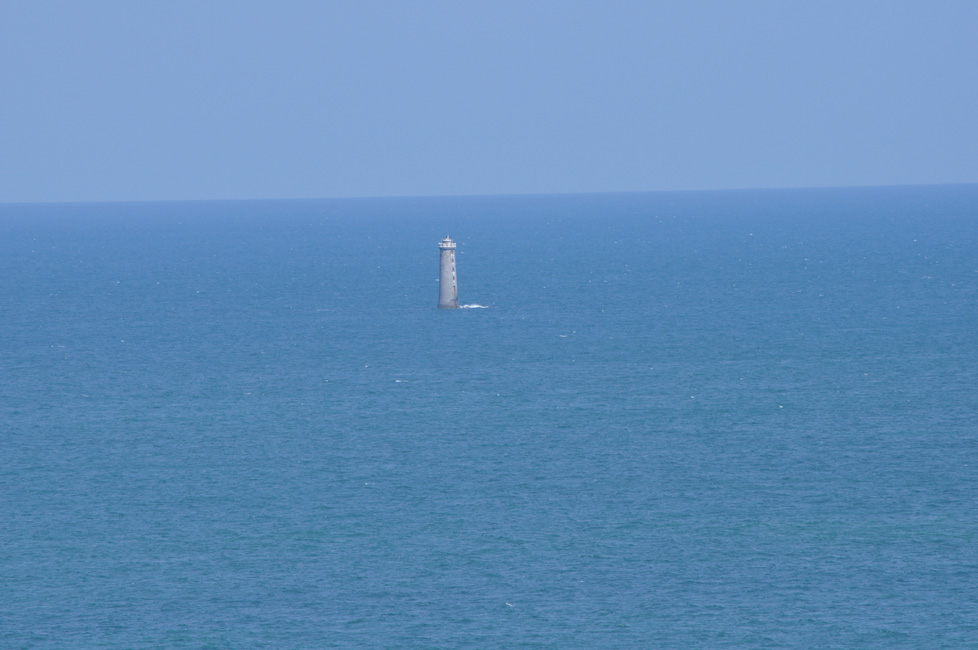
Ecco, se anche a voi prende questa smania, se anche voi conoscete questa irresistibile inquietudine, allora sapete di cosa parlo. Un desiderio che si autoalimenta fino a che non viene appagato. Ma desiderare è già un po’ partire, è già un po’ essere lì (e, di questi tempi, desiderare è ciò che ci tiene vivi in mancanza di viaggi veri). E dal desiderio alla concretizzazione di esso è tutto un progettare, fantasticare, pensare. Fino al giorno in cui non metto finalmente piede in quel luogo, ed entro anche io in quel paesaggio come un attore in una inquadratura. Ed è magia. Finalmente mi ritrovo nella regione della Nuova Aquitania, quasi trasportata dai fotogrammi di quella pellicola. La regione si chiama così solo dal 2016, quando sono stati unificati sotto un’unica denominazione i territori di Aquitania, Limosino e Poitou-Charentes, creando la più estesa regione di tutta la Francia.
L’Ile de Ré è un terra calcarea e argillosa intrisa d’acqua, dove la salsedine portata dai venti oceanici sui vitigni aiuta la maturazione e concorre alla creazione di eccellenti vini bianchi e rosati, ma anche di cognac raffinati e profumatissimi, ottenuti principalmente dall’Ugni Blanc, un’uva che conferisce al liquore un ricco bouquet di aromi floreali.
Perdersi tra i vigneti di quest’isola, pedalando lentamente come se non ci fosse un domani è il miglior consiglio che io possa dare a chi ancora non c’è stato. E mentre la brezza vi accarezza il viso ed i più affascinanti ucccelli migratori vi volano accanto, non sarà difficile illudervi di incontrare Molière che pedala al vostro fianco (se avete visto il film non riuscite a staccarvi da quelle immagini). E se invece di Molière incontrate un leggiadro Cavaliere d’Italia (Himantopus il suo nome latino) con le sue esili zampe rosse immerse nella palude, o un airone cenerino intento a catturare un pesce a filo d’acqua, allora scoprite di essere in una vera oasi naturale.
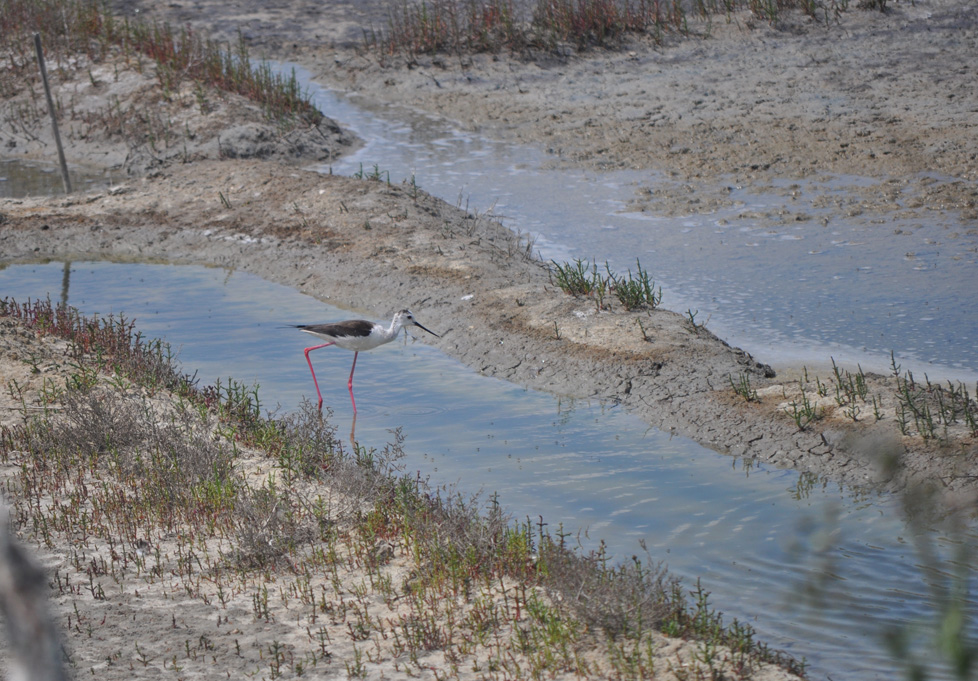
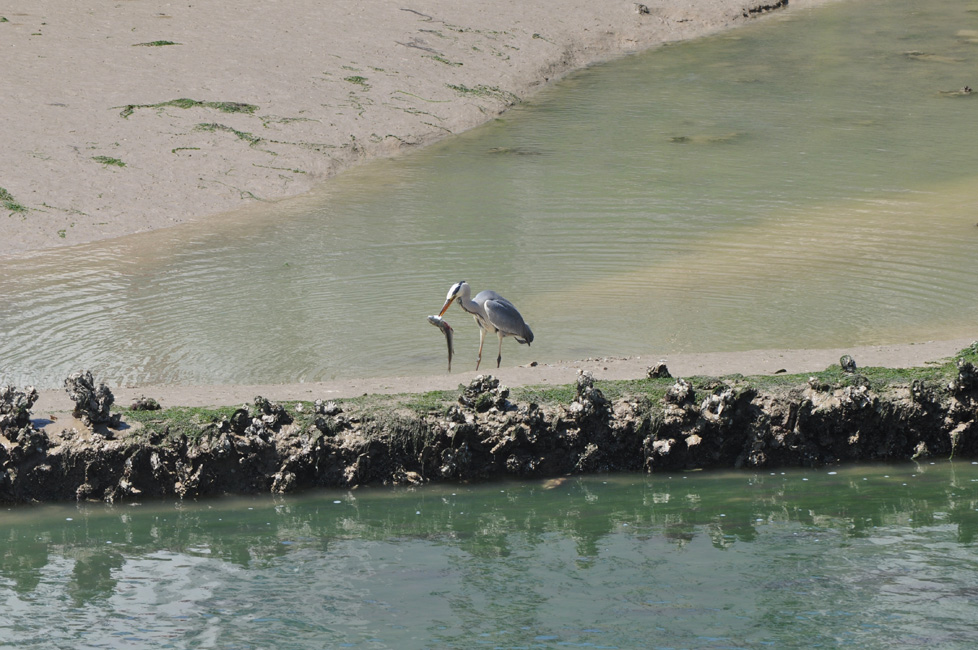
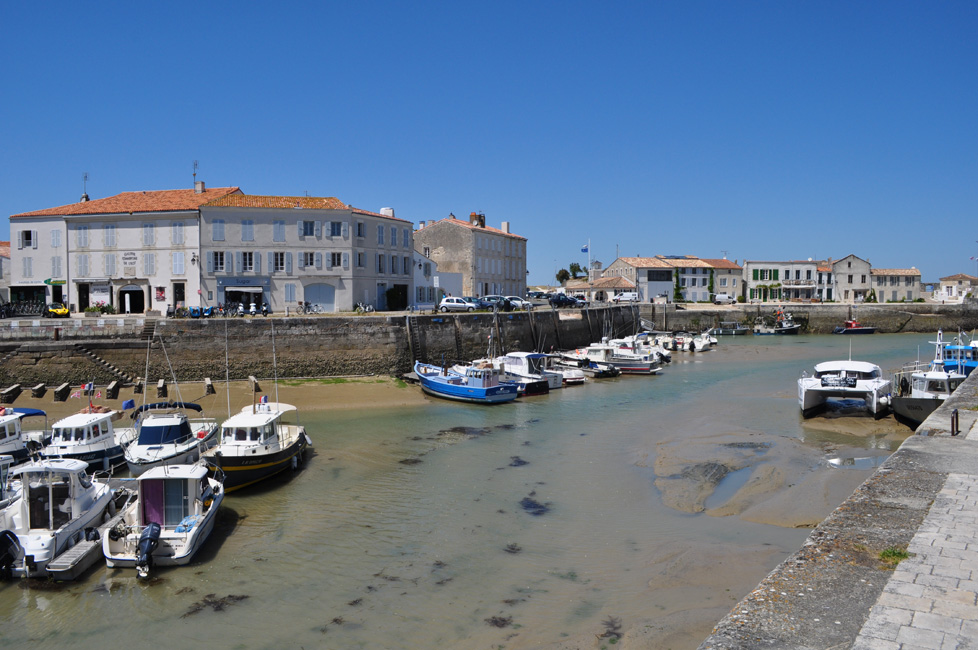
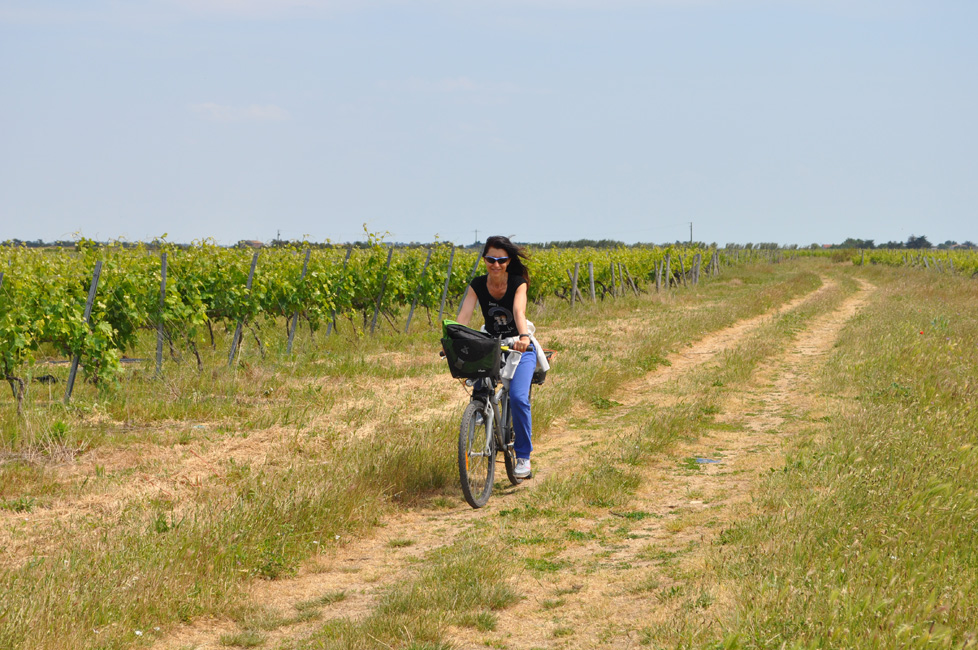
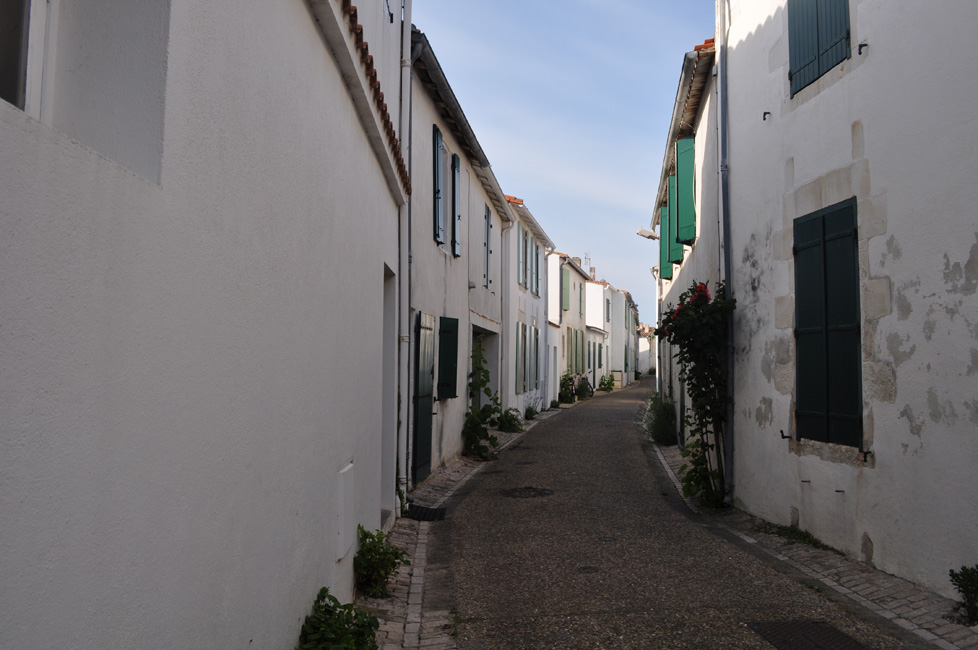
Un’altra caratteristica affascinante sono i fari dell’isola: il più imponente è il Faro delle Balene, la cui struttura più antica, alta 29 metri, risale al 1682, oggi restaurata è sede di un museo insieme all’edificio adiacente che ospitava la scuola di formazione dei guardiani del faro. A pochi metri da questa antica torre si erge il nuovo Faro delle Balene, costruito nel 1854, che segnala la costa dall’alto dei suoi 59,39 metri, con un raggio d’azione di circa 50 chilometri. Una vera stella dei mari a illuminare le rotte notturne. Il nome deriva dai numerosi arenamenti di balene che si sono verificati nel corso della storia sulla punta settentrionale dell’isola di Ré.
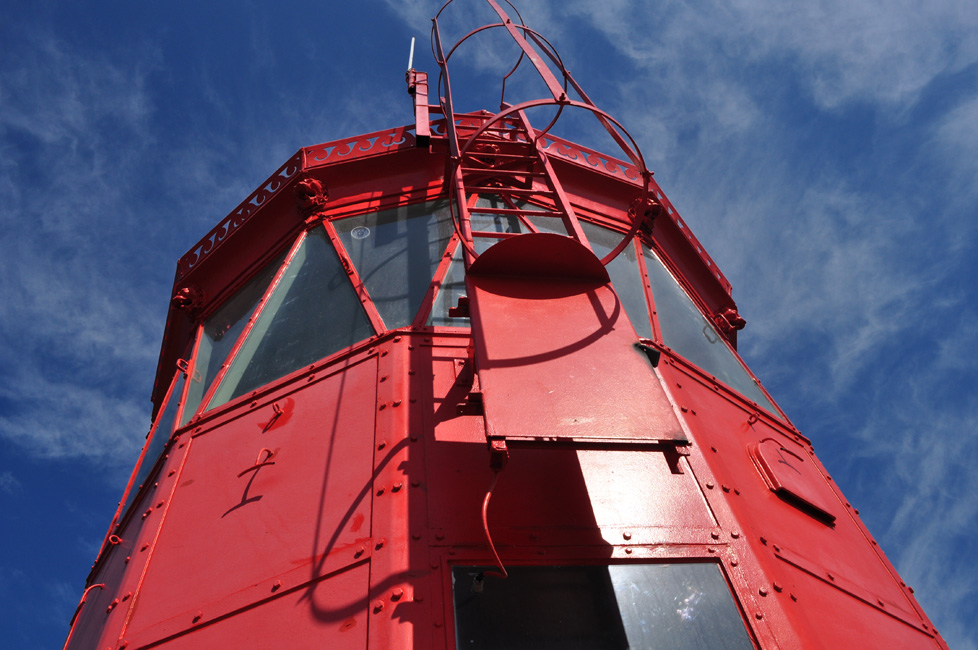
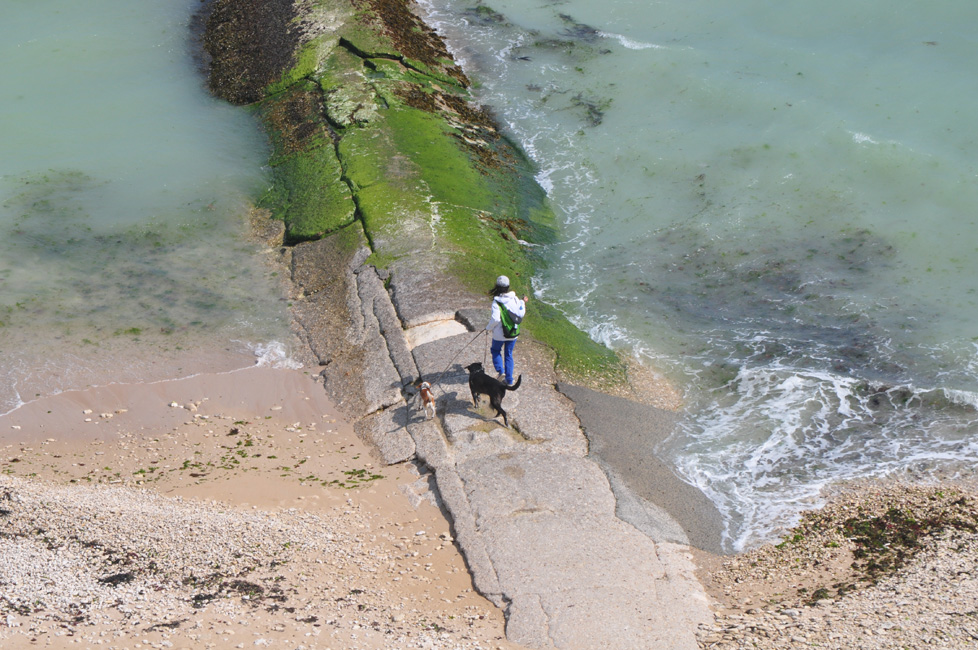
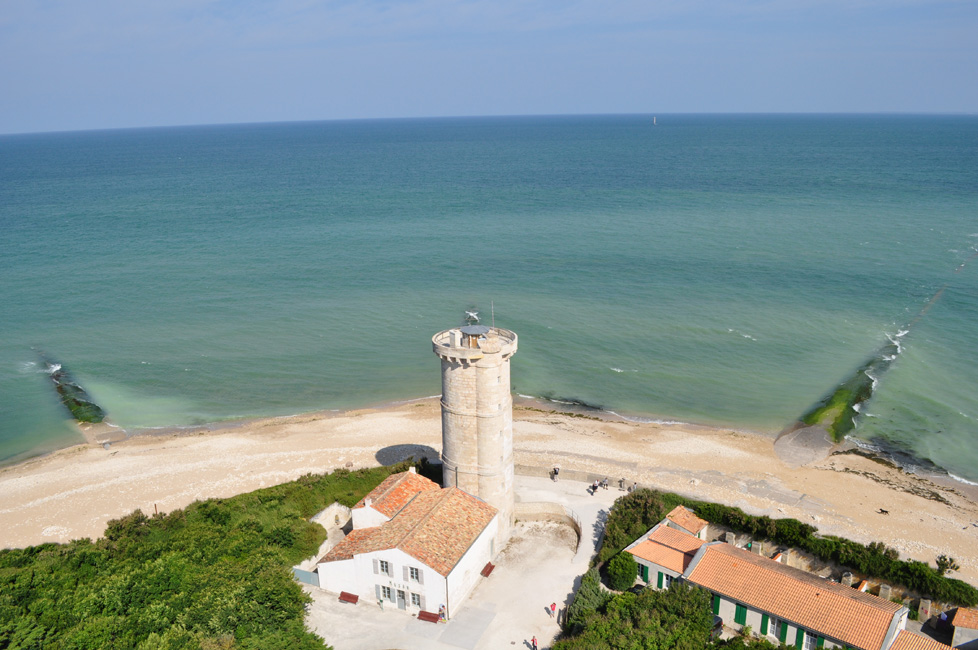
La forza attrattiva di un paesaggio però a volte non scaturisce da un unico film, è piuttosto il risultato di numerose visioni cinematografiche e suggestioni letterarie che si sovrappongono nelle nostre esperienze.
S’intitola Piccole bugie tra amici (titolo francese Les petits mouchoirs) l’altro film che ha agito in me come una leva di propulsione spingendomi a visitare la Nuova Aquitania (non sarà mica che mi piace il cinema francese?). Diretto da Guillaume Canet, è una commedia amara ambientata tra Cap Ferret, La Rochelle e la Duna di Pilat. Il film è una coinvolgente storia di amicizia fatta di fragilità, di delusioni, di tradimenti e bugie, una sorta di “The big Chill” alla francese. Ma al di là della storia intrigante non si può restare indifferenti davanti a quelle spiagge dorate baciate da un mare che vira tra il verde e l’azzurro cristallino. La bellezza incontaminata delle location del film, tra Cap Ferret e la Duna di Pilat diventa come un magnete che ti attira e ti inghiottisce dentro il suo fascino fino a consumarti di desiderio. E se decidi di abbandonarti a questa forza magnetica, ecco che prima o poi ti ritrovi proprio lì, su quella gigantesca duna di sabbia che riesci a scalare solo attraverso rampe talmente verticali che ti chiedi se non ti stiano portando in cielo. E quasi quasi ci credi davvero che stai per toccare il cielo, perché arrivi talmente in alto che se ti guardi indietro vedi le persone e gli alberi, giù in fondo, piccoli come formiche. E forse sei davvero in Paradiso, perché quello che vedi non l’hai mai visto: una sconfinata montagna di sabbia che si erge a perpendicolo tra un mare di un turchino accecante e un cielo costellato di kite surf coloratissimi che si librano in volo. E’ un estasi di infinita bellezza. E diventi parte di quella bellezza che stai ammirando con il fiato corto, per il senso di sublime che percepisci.

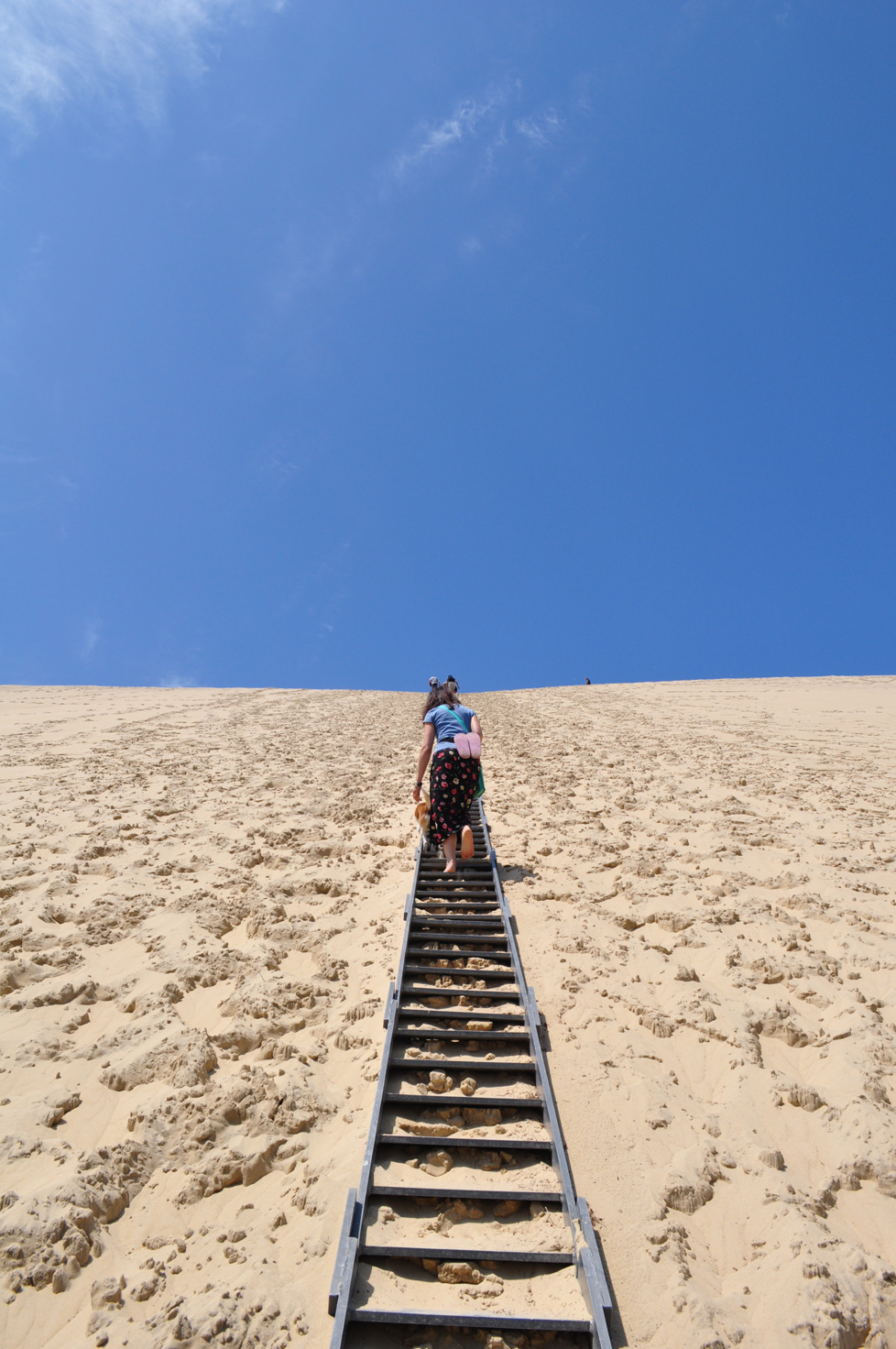
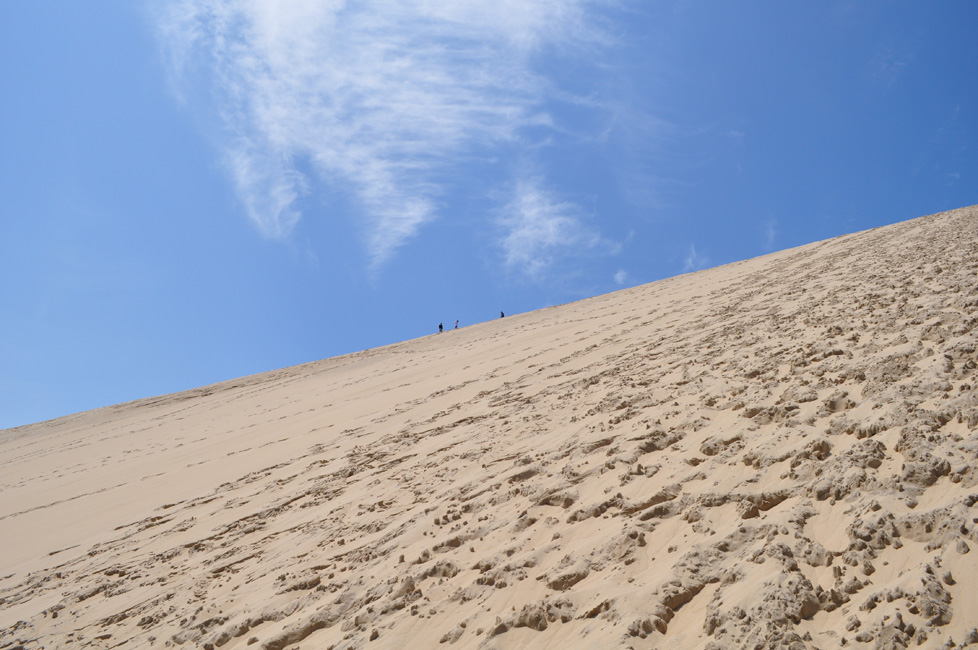
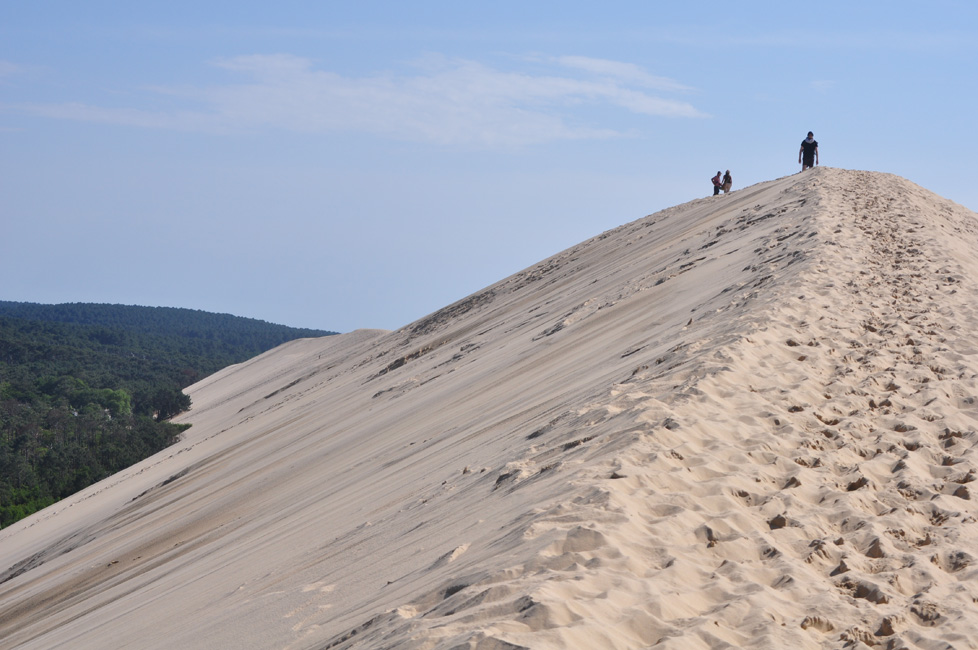
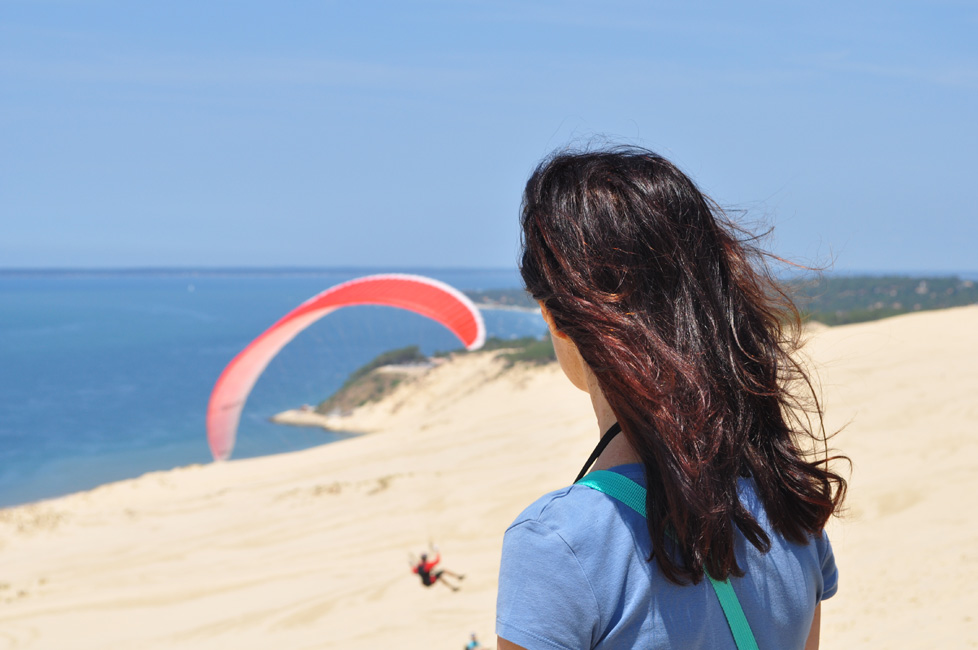
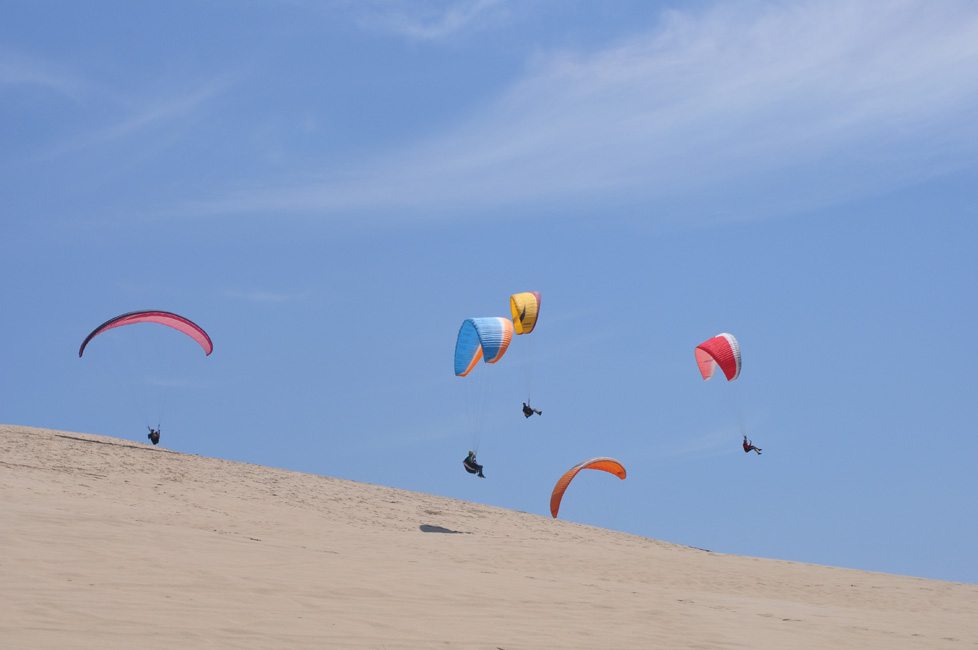
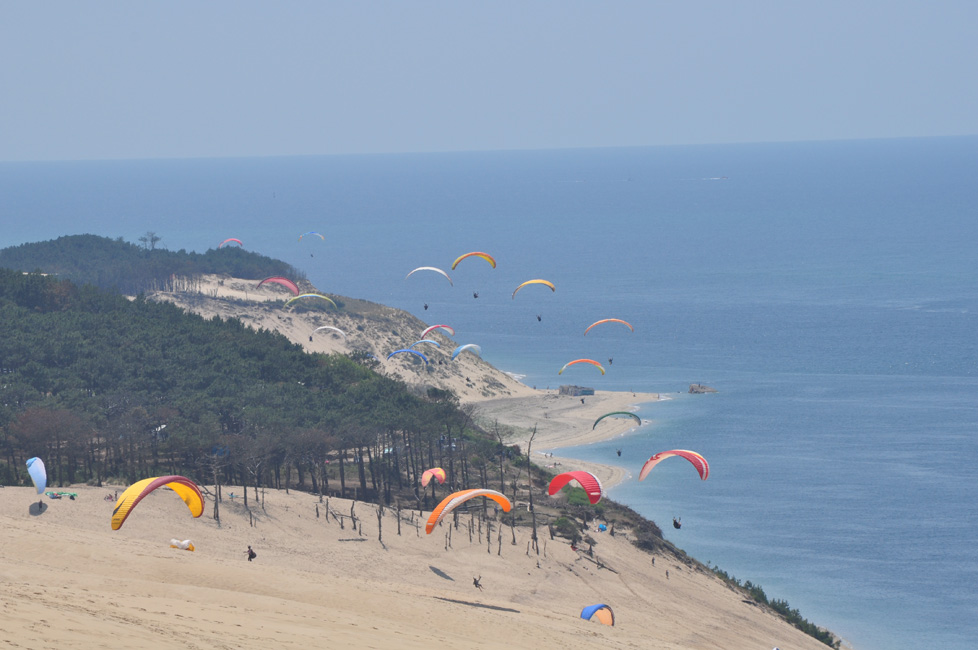
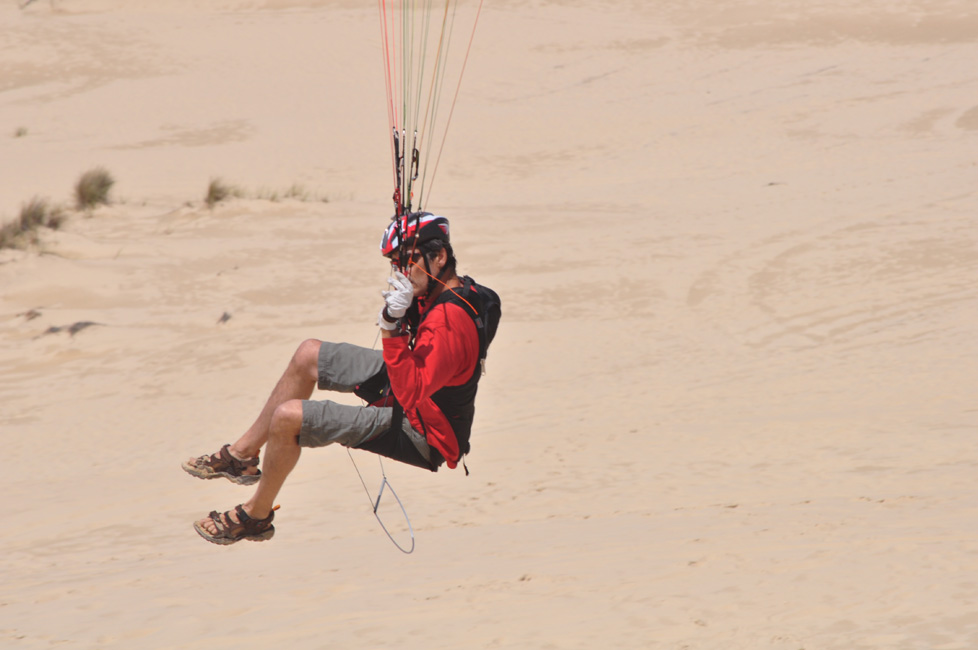
L’esistenza della Duna di Pilat è frutto dei venti che, a partire dal XVIII secolo, concentrano in quella zona enormi quantità di sabbia creando la più grande duna di tutta Europa, un paesaggio unico al mondo. Una volta conquistata la vetta, sarà davvero difficile lasciarla. E anche quando l’avrete fatto, resterete contagiati per sempre dalla voglia quasi patologica di ritornarvi.
Ma c’è stato anche un libro che mi ha portata fino in Nuova Aquitania, ed è il romanzo di Georges Simenon I fantasmi del cappellaio (titolo originale Les Fantômes du chapelier), ambientato nella cittadina di La Rochelle, proprio quella località dalla quale parte il lungo ponte che vi porta all’Ile de Ré. E’ la città dove si svolge ogni anno il Festival Internazionale del Cinema, il più importante di Francia dopo il Festival di Cannes, ma anche il La Rochelle Jazz Festival, la cui ventiquattresima edizione si terrà dal 13 al 17 ottobre 2021.
Nelle pagine di Simenon, La Rochelle appare come città livida e cupa, afflitta da una pioggia costante e insistente, palcoscenico di una serie di omicidi inquietanti. Le sue strade anguste, buie e silenziose fanno da sfondo a una storia conturbante, come solo Simenon sa creare. Ma quando, catturati da quelle pagine, arriverete poi davvero a visitare La Rochelle, la scoprirete solare e luminosa, con le sue case in pietra chiara, l’imponente torre del grande orologio, la cattedrale di Saint Louis e il suo vecchio porto con lo spettacolare fenomeno delle maree. A dimostrazione che il punto di vista di Simenon sulla città è solo la vista da un punto. Voi potrete scoprirne altri, riscrivendo nuovi, personali ed intimi percorsi di esplorazione.

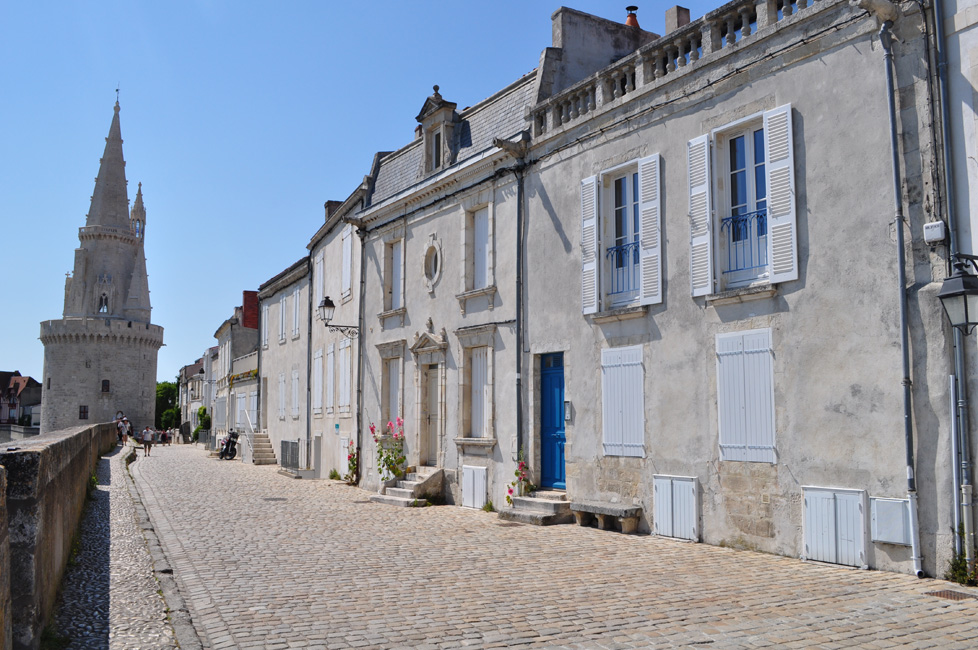
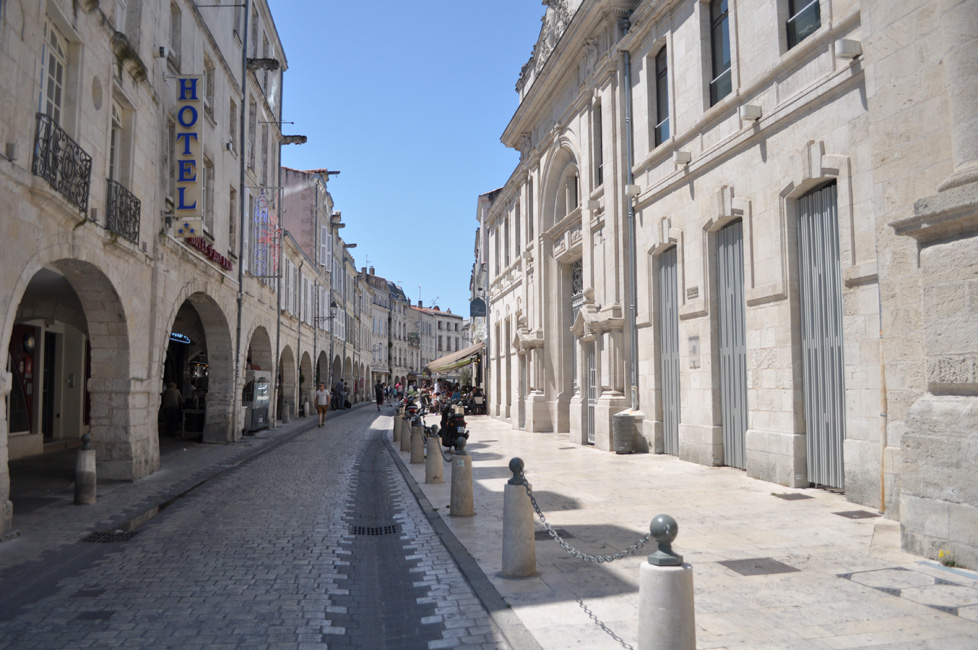
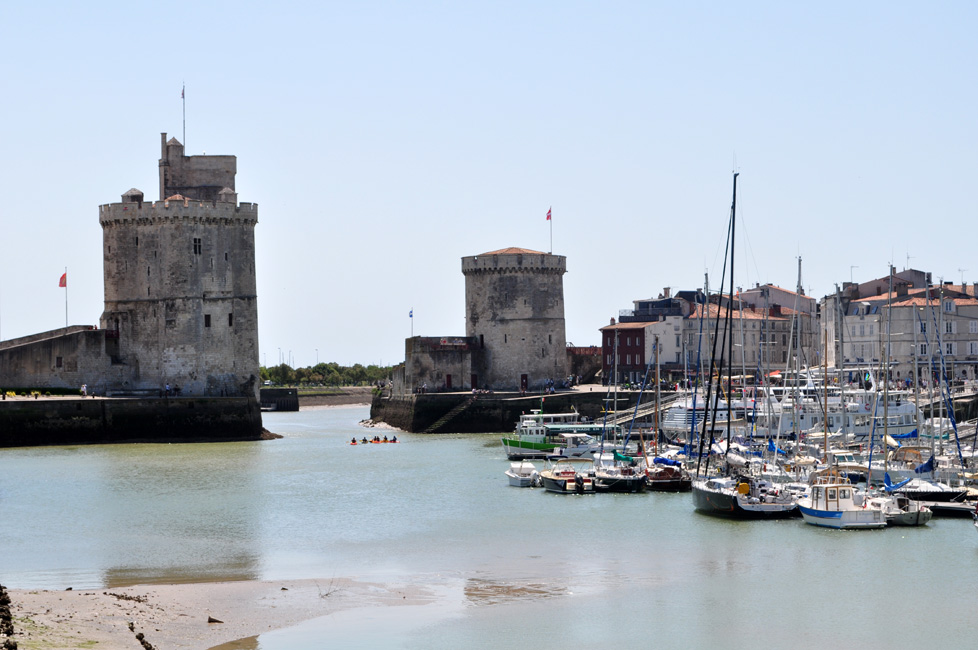
ENGLISH VERSION
Today I tell you how I ended up in New Aquitaine. It was the cinema.
How many times have you ever felt conquered by a movie set? How many times have you felt attracted to the city or country where that film was shot? It often happens to me when in a film the outdoor scenes are numerous, and they allow me to discover landscapes unknown to me. I immediately have the desire to rush right there, in those unknown places, to explore them following the footprints of the protagonists. But it is not a question of fetishistic exaltation towards that film set. I honestly don’t give a damn about the actors who were there. I’m not interested in seeing where the two protagonists kissed or where that chase took place. I let myself be seduced by the landscape scrutinized by the director’s eye, by his shots, by his photography, by his chiaroscuro effect. It is that gaze that conquers me, and that I want to go and find myself, in person, reaching those places. This is how I left for New Aquitaine.
Indeed, to be honest, I almost always leave in this way, under the pressure of a film or a novel, to discover new landscapes and unusual atmospheres. And that’s how I discovered the Ile de Ré, in New Aquitaine. It happened with the film Cycling with Molière, by Philippe Le Guay, with the amazing Fabrice Luchini, a very talented French actor.
The film is all set on the Ile de Ré, an island in the Atlantic Ocean that I was completely unaware of before seeing that film. An island that today is actually a peninsula because it is connected to the charming city of La Rochelle by a three-kilometre long bridge, but which was originally an archipelago made up of three small islands.
And this conformation makes it fascinating, because it is full of canals that go through the fields, and of salt flats and marshy environments that alternate with sand dunes, vineyards and villages with small white houses. An enchantment of this kind was completely unknown to me, until that evening when I see those landscapes scrolling on the screen, in front of my eyes, while the shot captures the protagonist who goes away by bicycle dressed as Molière.
It is like a shock: I want to go there, I want to get lost among those salt pans, I also want to pedal among those fields, admire those wonderful birds that hover over those calm waters, I want to get lost among the different cantons of the island, I want to climb on its white stone headlights to scan the horizon, I want to sink into the soft sand dunes that dot it, dunes where another film was shot in 1962, The Longest Day, by Cornelius Ryan, dedicated to the Normandy landings. But those were other atmospheres not to be relived.
Well, if you too get this craving, if you too know this irresistible restlessness, then you know what I’m talking about. A desire that feeds itself until it is satisfied. But wishing is already a little bit of leaving, it is already a little bit of being there (and, these days, wishing is what keeps us alive in the absence of real trips). And from the desire to the realization of it, it is all a planning, fantasizing, thinking. Until the day I finally set foot in that place, and I too enter that landscape like an actor in a shot. And it’s magic. Finally, I find myself in the New Aquitaine region, almost transported by the frames of that film. The region has been so-called only since 2016, when the territories of Aquitaine, Limousin and Poitou-Charentes were unified under a single name, creating the largest region in all of France.
Ile de Ré is a calcareous and clayey land soaked in water, where the salt carried by the oceanic winds on the vines helps the maturation and contributes to the creation of excellent white and rosé wines, but also of refined and fragrant cognac, obtained mainly from Ugni Blanc grape, a grape that gives the liqueur a rich bouquet of floral aromas.
Getting lost in the vineyards of this island, riding slowly as if there was no tomorrow is the best advice I can give to those who haven’t been there yet. And while the breeze caresses your face and the most fascinating migratory birds fly around you, it won’t be difficult for you to fool yourself into meeting Molière bicycling alongside you (if you’ve seen the film, you can’t tear yourself away from those images). And if instead of Molière you meet a graceful Knight of Italy (Himantopus his Latin name) with its slender red legs immersed in the swamp or a grey heron intent on catching a fish on the water, then you will discover that you are in a true natural oasis.
Another fascinating feature is the presence of lighthouses on the island: the most impressive is the Lighthouse of the Whales, whose oldest structure, 29 meters high, dates back to 1682, now restored it is home to a museum together with the adjacent building that housed the lighthouse keepers training school. A few meters from this ancient tower stands the new Lighthouse of the Whales, which was built in 1854, which signals the coast from its 59.39 meters, with a range of about 50 kilometres. A true star of the seas to illuminate the night routes. The name derives from the numerous whale strands that have occurred throughout history on the northern tip of the island of Ré.
The attractive force of a landscape, however, sometimes does not arise from a single film, it is rather the result of numerous cinematographic visions and literary suggestions that overlap in our experiences.
Another film that acted in me as a propulsion lever, pushing me to visit New Aquitaine is called Little white lies (French title Les petits mouchoirs, is it not that I like French cinema?). Directed by Guillaume Canet, it is a bitter comedy set between Cap Ferret, La Rochelle and the Dune of Pilat. The film is an engaging story of friendship made of fragility, disappointments, betrayals and lies, a sort of French-style “The Big Chill”. But beyond the intriguing history, one cannot remain indifferent in front of those golden beaches kissed by a sea that veers between green and crystalline blue. The pristine beauty of the film locations, between Cap Ferret and the Dune of Pilat, becomes like a magnet that attracts you and engulfs you in its charm until it consumes you with desire.
And if you decide to abandon yourself to this magnetic force, sooner or later you will find yourself right there, on that gigantic sand dune that you can only climb through ramps so vertical that you wonder if they are taking you to heaven. And you almost really believe that you are about to touch the sky because you get so high that if you look back you see the people and the trees, down below, as small as ants. And maybe you really are in Paradise, because what you see you have never seen: a boundless mountain of sand that rises perpendicular between a blinding blue sea and a sky dotted with colourful kite surfs that soar in flight. It is an ecstasy of infinite beauty. And you become part of that beauty that you are admiring with shortness of breath, for the sense of sublime you perceive.
The existence of the Dune of Pilat is the result of the winds that, starting from the 18th century, concentrated enormous quantities of sand in that area, creating the largest dune in Europe, a unique landscape in the world. Once you have conquered the summit, it will be really difficult to leave it. And even when you have done it, you will be forever infected by the almost pathological desire to return.
But there was also a book that took me to New Aquitaine, and it’s Georges Simenon’s novel The Hatter’s Ghosts (original title Les Fantômes du chapelier), set in the town of La Rochelle, the very place already mentioned, connected to the Ile de Ré by a long bridge. It is the city where the International Film Festival takes place every year, the most important in France after the Cannes Film Festival, but also the La Rochelle Jazz Festival, whose twenty-fourth edition will be held from 13 to 17 October 2021.
In the pages of Simenon, La Rochelle appears as a livid and gloomy city, afflicted by constant and persistent rain, the stage for a series of disturbing murders. Its narrow, dark and silent streets are the backdrop to a disturbing story, as only Simenon can create. But when captured by those pages, you then really come to visit La Rochelle, you will discover it sunny and luminous, with its light-coloured stone houses, the imposing tower of the great clock, the Saint Louis Cathedral and its old port with the spectacular phenomenon of the tides. To demonstrate that Simenon’s point of view on the city is only the view from one point. You will be able to discover others, rewriting new, personal and intimate paths of exploration.
